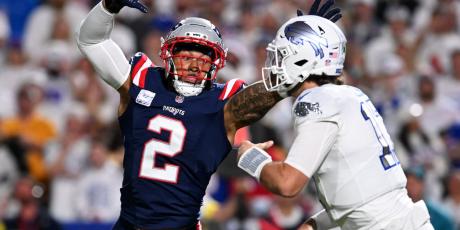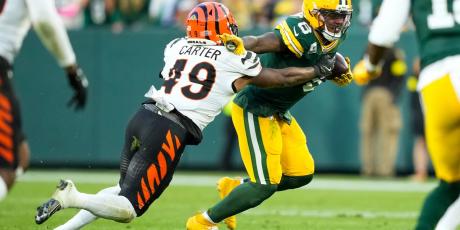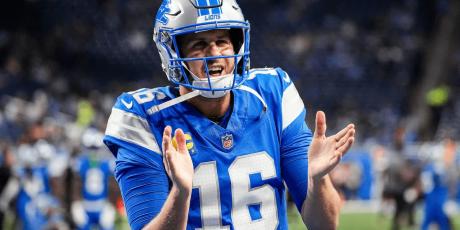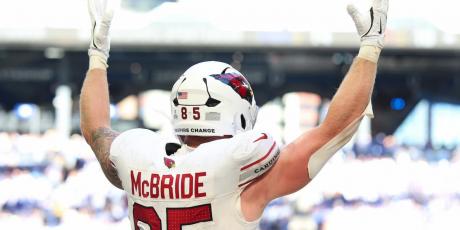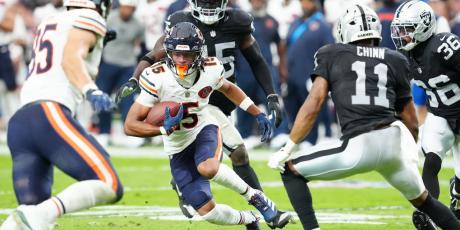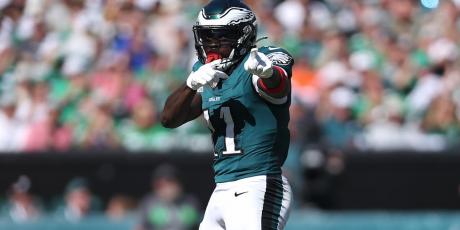How to Identify an IDP Prospect: Edge Rushers
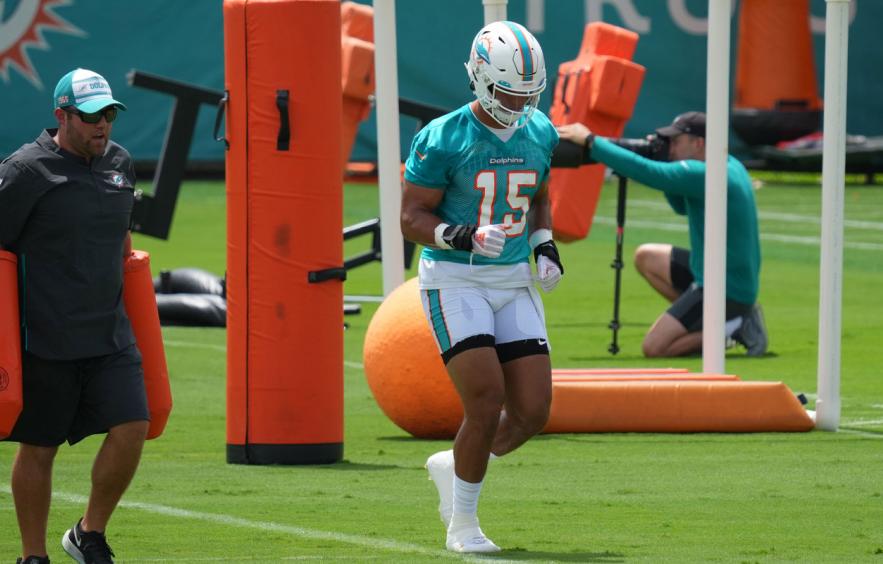
Like most inquisitive, argumentative children, I was always told as a kid that I should someday become a lawyer. I don’t think I had a warped view of reality, but if someone else’s perspective differed from mine, I wanted to drill down to why they thought the way they did. If their answer wasn’t satisfactory, I would take that as an invitation to convince them of my point of view.
I still may not fully believe the notion that one cannot reason someone out of an idea they were not reasoned into. After all, I write fantasy football content, don’t I?
Many people playing in Individual Defensive Player (IDP) leagues have fairly firm ideas about what makes a great defensive fantasy prospect. Not many have more than anecdotal evidence to support their reasoning, though. That’s why I’ve interrogated as many factors as possible, to see what traits or metrics will help us predict future success for IDP prospects.
More IDP Resources: Identifying D-Line Prospects | DBs to Target | IDP Rankings
We’ve already tackled defensive linemen, so next up are the edge rushers. What makes a successful edge defender, and how can we identify them before they play a single snap in the NFL?
IDP Projection Process
When I consider prospect success in fantasy football, I typically don’t just look at rookie impact. Especially in a dynasty league, you need to consider a longer-term view of a player. The most commonly accepted evaluation window is three years, which actually matches up with the average career length for an NFL player. Beyond this point, many other factors play into player production and longevity, making projecting Year 4 onward essentially fruitless for our purposes.
Due to all this, I set my parameters for IDP production as the first three years of a player’s career. That means our 10-year sample size includes all defensive players drafted between 2009 and 2018 (the most recent class to complete its third year).
The information I collected for players includes their NFL Combine (or Pro Day) testing data and college production (per CFB Stats). I compared them to NFL games played, total fantasy points (balanced scoring system; 3 points per big play to 1 point per tackle), fantasy points per game, NFL Draft position (overall pick number), and finally college production in each category to its NFL counterpart (e.g. college tackles per game to NFL tackles per game).
The comparisons I performed use the R correlation. Essentially, this takes two related datasets and compares them to each other, quantifying them with the aforementioned R’s coefficient—a numerical value between -1 and 1. The closer to either of these the coefficient is, the stronger it is, but a value closer to 0 represents an insignificant statistical relationship. A perfect 1.00 coefficient would be represented graphically by a line rising at a 45-degree angle, showing that as one factor increases (college tackles per game, for instance), its partner also increases (NFL tackles per game) at the same rate. In data sets this large, however, coefficients tend to be on the small side, so we’re looking for the most significant ones to help us identify signposts in prospecting.
I’ll walk through the significant prospect correlations, from the strongest on down.
Overall Draft Slot
| Category | Value |
|---|---|
| Drafted in Round 1 | 56.0% |
| Drafted in Round 4 or Later | 8.0% |
| Average Overall Draft Value | 37.1 |
As for defensive linemen before, draft value is extremely substantial when evaluating edge defender prospects. With a -0.61 correlation coefficient, edge rusher correlates the best to overall draft pick among the IDP positions, and this has two very good reasons.
First, if an NFL team likes an edge rusher enough to draft them early, they have probably done their homework on the player’s athleticism, production, team scheme fit, and off-field background. Draft value, therefore, is sort of a one-stop-shop for baking all of that into a single number. Second, early-round draft picks are the highest rookie currency a team can spend on a player, and if they’re “paying” top dollar in the NFL Draft for these players, they are going to expect a top-tier return on their investment. More expectation means more playing time, and more playing time means more chances to earn fantasy points for your IDP teams.
There’s also little difference in the correlation coefficients of draft value with total fantasy points over the first three years, fantasy points per game over that time, and playing time. The earlier the player goes in the draft, the more likely it is that they have an innate talent that sets them above their peers. Needless to say, draft capital is king in fantasy prospecting.
Speed Score
| Category | Values |
|---|---|
| Average 40 Time | 4.70 sec. |
| Average Weight | 261 lb. |
| Average Speed Score | 107.3 |
For all the flak that the straight-line 40-yard dash catches, it actually ends up being pretty predictive of fantasy success at the edge rusher spot. Even slightly better, however, is the weight-adjusted 40 time – better known as speed score. A player running a 4.3-second 40-yard dash is impressive no matter what, right? But what if you have two edge rushers running a 4.3 40, where one of them weighs 230 pounds and the other weighs 280?
If you reach back to your high school physics class, you’ll remember that “force equals mass times acceleration”. We want our defenders delivering as much pop (force, if you will) as possible, so it follows that the bigger guy who can move just as fast is capable of delivering more force in his hits. That’s just science, baby, and that’s why we find a pretty meaningful 0.34 correlation coefficient for speed score with early-career fantasy production for edge rushers. Scouts talk about pass-rushers who can convert speed to power, but guys like Von Miller and Preston Smith prove that you have to have speed to start with before you get out those conversion tables.
College Tackles for a Loss (TFL) per Game and Sacks per Game
| Category | TFL per Game | Sacks per Game |
|---|---|---|
| Average NFL | 0.73 | 0.56 |
| Average College | 1.06 | 0.56 |
| Average College Share | 15.5% | 22.1% |
What do edge rushers do? On an even more forward-moving bent than defensive linemen, they attempt to disrupt the offense. Still, linemen often have to maintain the line of scrimmage to prevent the run game from eating away precious yardage, and linebackers and secondary are all about reacting to the offense to stop it. Edge defenders, however, are the proactive saboteurs that rack up fantasy points by getting into the backfield and bringing down the quarterback or ball carrier. We count those disruptions up and call them TFLs and sacks.
It holds to reason that if a player is able to create negative plays for the offense in college, that skill will transfer over to the pros as well. That’s why we see correlation coefficients between fantasy points and TFLs per game and sacks per game of 0.31 and 0.25, respectively. The elite tier of fantasy edge players averaged about 1.1 TFL per game and 0.6 sacks per game in college—this while usually playing for and against high-profile programs. Matt Judon is the only one who sticks out as coming from a much smaller program, but he posted college marks well over the average of his elite peers and has clearly held his own in the NFL.
The Best of the Rest
It always fascinates me how physical profiles don’t actually correlate to fantasy success nearly as well as fantasy prospectors expect them to, but edge rusher is one of the few exceptions in IDP evaluation. The final two categories that are important are both athletic metrics: broad jump (and, to a lesser extent, the vertical jump) and catch radius.
Considering how much more value straight-line explosion is than agility at this position in terms of testing, acing the jumps fits into this picture quite well. While I can’t say for certain, my theory is that the broad jump more accurately reflects an edge rusher’s get-off from the snap in a horizontal plane, and that is why it is a more translatable metric than the vertical jump.
Catch radius is compelling because it does suggest that size matters less as individual components of weight, height, and arm length, but as a function of all of those pieces working together. With athleticism factored in, this gives us a sense of an edge player’s reach and range in tight areas and his ability to match up with massive and agile offensive tackles.
2021 Rookie Edge Rusher Standouts
Jaelan Phillips, Dolphins
Jaelan Phillips went to the Miami Dolphins as the first edge player off the board in the 2021 NFL Draft, securing a clutch top percentile rank in this most important of metrics. After that, the 260-pound Phillips picked up a 91st percentile speed score (4.63 40-yard dash) and 80th percentile marks in both jump tests. He measured up as well, with an 89th percentile catch radius highlighting a 6-foot-6 frame with 33.25-inch lever arms attached. Only his production was a bit off, with a sub-50th percentile rate of TFL per game, but he did assemble a strong 80th percentile sacks per game rate. Phillips has some flaws in the health department, but his case to be the best fantasy prospect in this edge rusher class is impeccable.
Carlos Basham, Bills
The Buffalo Bills’ Carlos Basham is a distant second to Phillips—fitting since he was a second-round pick as well. Basham actually shows up ahead of position-mate and new teammate Gregory Rousseau in my model, which is surprising since Rousseau was selected before Basham. The Wake Forest product simply has a stronger profile, though; what can I say? His 97th percentile speed score gets things going with a bang, even if his jumps (60th percentile vertical and 77th percentile broad) are a little more pedestrian. Despite solid agility drill testing, Basham’s catch radius also ends up in the good-not-great range at the 71st percentile. It’s hard to ignore his production, though, with 80th and 71st percentile TFL per game and sacks per game, respectively. I’ve been pleased to get Basham significantly later or cheaper than Rousseau and feel just as good—if not better—about his chances to succeed.
Joseph Ossai, Bengals
The lowest-drafted player in my model’s top-five is third-round Texas product Joseph Ossai of the Cincinnati Bengals. No one is quite sure how the hybrid edge player will fit into the Cincy defense just yet, but the fact remains that he has a lot of talent that my model is highlighting. His 80th percentile speed score, top percentile vertical jump, 97th percentile broad jump, and 83rd percentile catch radius suggest an explosive player profile waiting to be unlocked. Ossai is mostly projection at this stage, with sub-50th percentile marks in both TFL per game and sacks per game. With the right coaching and role, though, he can turn his elite athleticism into fantasy success.
Gregory Rousseau, Bills
Another Miami edge product, Gregory Rousseau was the first Buffalo draft pick this year but has a less polished profile than his second-round peer. Rousseau largely makes his place here on the back of 94th percentile draft capital and a top percentile rank catch radius, though a 77th percentile speed score is just fine as well. He also was disruptive in the run game, with a 94th percentile TFL per game rate and an average sacks per game rate. Rousseau was drafted this high off the back of upside, which makes me put him a tier lower than Phillips and a step lower than Basham. He still could develop into a fantasy star, however.
Azeez Ojulari, Ravens
Finally, Azeez Ojulari is a player who may go under the radar in your league unless you use custom positions or heavily reward big plays. The New York Giants selected the outside linebacker in the middle of the second round, earning him 86th percentile draft capital. He turned in a 77th percentile speed score and an 86th percentile broad jump to add to a 97th percentile catch radius, making him a long and explosive edge threat. In college at Georgia, he proved to be quite the disruptor, too; Ojulari earned the top percentile ranks in both TFL per game and sacks per game. Don’t sleep on this versatile pass-rush threat as a late flier in your dynasty leagues.


